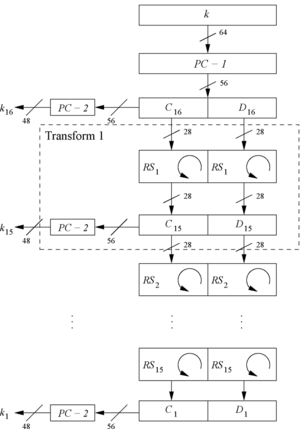A slecture on Cryptography by student Divya Agarwal and Katie Marsh.
Partly based on the Summer 2015 lecture material of Paar.
Decryption - Theory
DES as discussed is based on Feistel networks. And in Feistel ciphers only the keyschedule has to be modified for decryption.
Step 1: Generate the same 16 round keys in reverse order for decryption, that is given initial key $ k $ can we get $ k_{16} $ and the rest.
Step 2: As D0=D16 and C0=C16 the first round key can be generated by applying PC-2 right after PC-1 (no rotation here!). Refer Fig 1 for more details.
Step 3: All other rotations of C and D can be reversed to reproduce the other round keys resulting in:
* No rotation in round 1. * One bit rotation to the right in rounds 2, 9 and 16. * Two bit rotations to the right in all other rounds.
Step 4: Note, the decryption and encryption function are the same essentially.
The complete lecture by Prof. Paar can be found here.
References
- C. Paar. Understanding Cryptography. Lecture Notes. Dept. of Electr. Eng. and Information Sciences, Ruhr University.
- C. Paar and J. Pelzl. Understanding Cryptography. A textbook for Student and Practitioners. Springer 2010.
Questions and comments
If you have any questions, comments, etc. please post them here.


